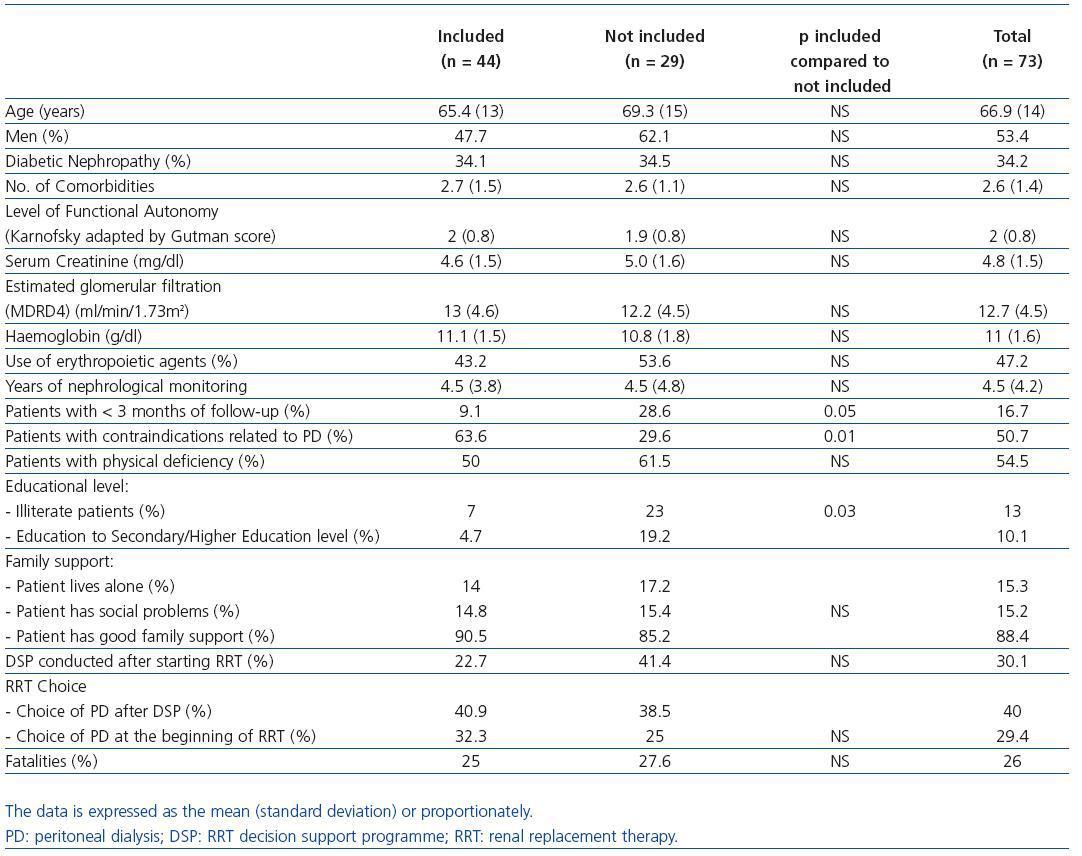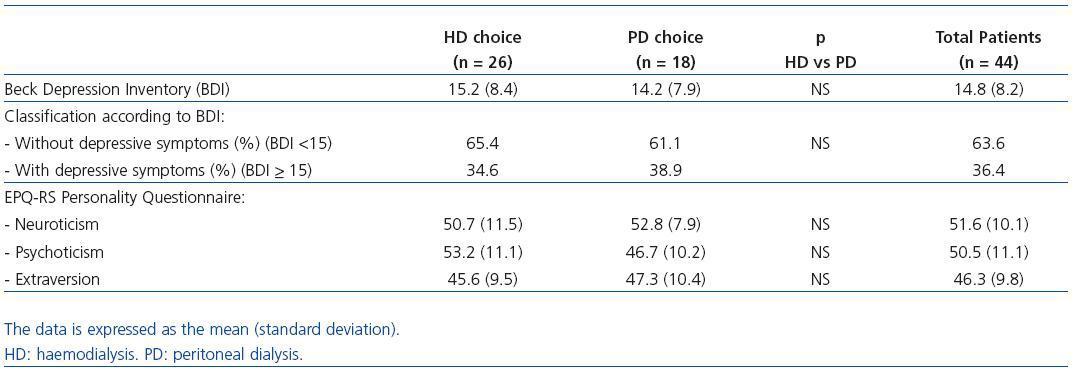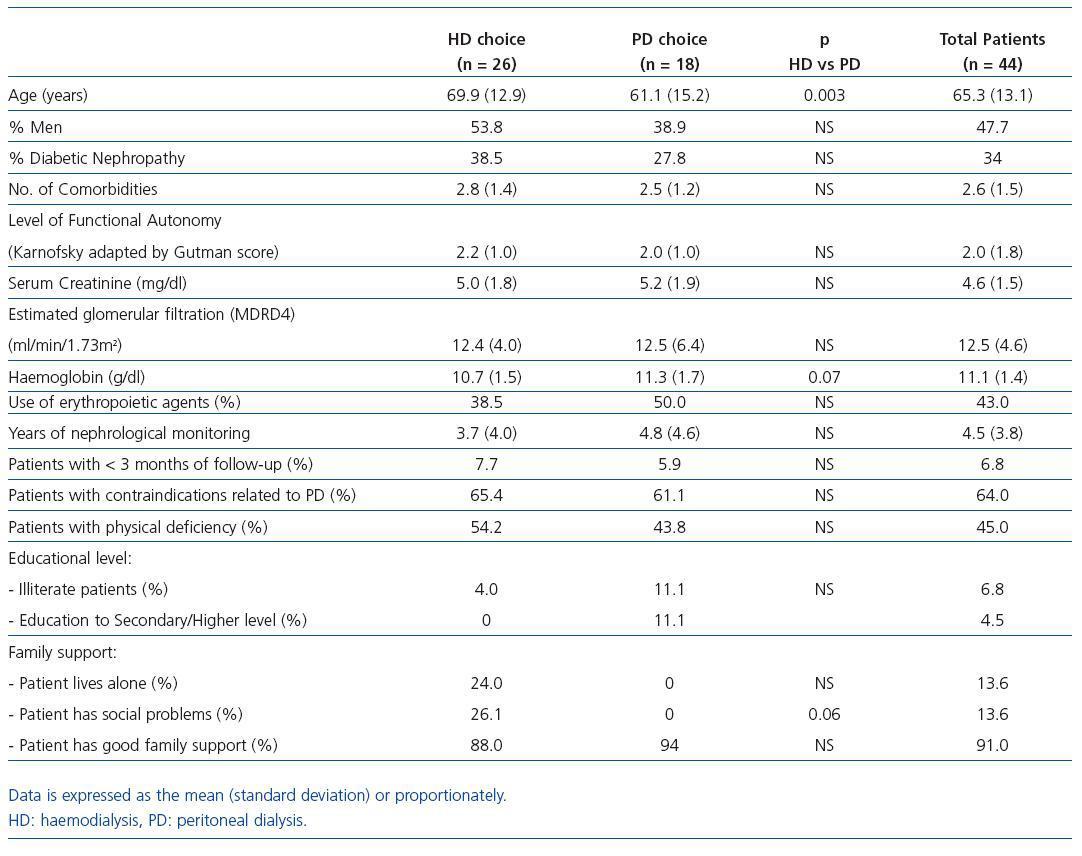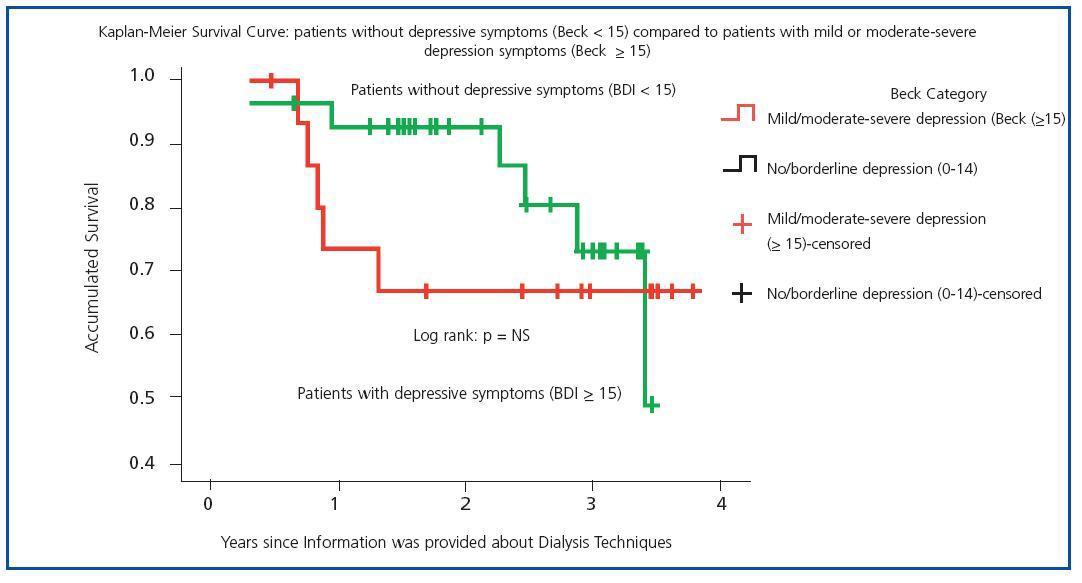Background: Peritoneal dialysis (PD) is not frequently used in our setting. Objective: To analyze the psychological factors involved in the choice of renal replacement therapy (RRT). Material and methods: Prospective observational study of stable patients without cognitive or sensory deficits, who were informed about RRT from January 2004 to July 2006, and agreed to participate. The Beck Depression Inventory and the Eysenck personality questionnaire were administered. Clinical and sociodemographic data, and RRT choice were recorded. End of follow-up: 2007/10/31. Results: We studied 44 patients: age, 65.4 ± 13.1 years, 48% male, 34% diabetic. When choosing RRT, 36% of patients had depressive symptoms. Neither depressive symptoms nor personality traits were related to the choice of the dialysis type. Patients who chose PD (41%) were younger. After a mean follow-up of 8 ± 8 months, 70% of patients started RRT (68% hemodialysis [HD], 32% PD). None
of the patients who chose HD changed their mind, but 3 of the 13 patients (23%) who chose PD finally commenced HD, usually in the context of disease exacerbations. Half of the patients with depressive symptoms when choosing PD, and a third of the patients with higher levels of neuroticism changed their decision and finally opted for HD. Conclusions: When choosing RRT, the prevalence of depressive symptoms is high. Neither depression nor personality traits influenced the initial choice of RRT, but these factors may be involved in subsequent changes of the initial choice.
Antecedentes: La diálisis peritoneal (DP) se utiliza poco en nuestro medio. Objetivo: Analizar los factores psicológicos implicados en la elección del tratamiento sustitutivo renal (TSR). Material y métodos: Estudio observacional prospectivo de los enfermos estables y sin déficit cognitivo o sensorial que recibieron información del TSR entre enero de 2004 y julio de 2006 y que aceptaron participar. Se les entregaron para su cumplimentación el inventario de depresión de Beck y el cuestionario de personalidad de Eysenck, y se recogieron datos sociodemográficos, clínicos y el TSR elegido. El final del seguimiento fue el 31 de octubre de 2007. Resultados: Se estudiaron 44 pacientes: edad, 65,4 ± 13,1 años; 48% hombres; 34% diabéticos. Un 36% tenían síntomas depresivos. Ni éstos ni los rasgos de personalidad se relacionaron con la elección de la técnica. Eligieron DP (41%) los enfermos más jóvenes. Un 70% de los enfermos iniciaron TSR (68% hemodiálisis [HD], 32% DP) a los 8 ± 8 meses. Ninguno de los pacientes que eligieron HD cambió de opinión, pero tres de los 13 pacientes (23%) que habían elegido DP realizaron finalmente HD, en general en el contexto de agudizaciones. La mitad de los pacientes con síntomas depresivos y un tercio de los pacientes con mayores niveles de neuroticismo cambiaron su decisión inicial y optaron finalmente por la HD. Conclusiones: La prevalencia de síntomas depresivos en el momento de elegir TSR es elevada. Ni los síntomas depresivos ni los rasgos de personalidad influyeron en el TSR inicialmente elegido, aunque pueden ser factores implicados en los cambios de decisión posteriores.
INTRODUCTION
The two dialysis techniques, haemodialysis (HD) and peritoneal dialysis (PD), have shown that, in general, they are equally effective as forms of renal replacement therapy (RRT),1,2 although there are some differences in certain groups of patients, such as the elderly and diabetics.3 Recent publications even indicate the possible advantages of starting RRT with PD rather than HD,4 coining the concept of “integrated RRT”. Despite the two dialysis techniques being equally effective, the technical improvements of PD and the fact that it is more cost-effective than HD,5-7 the extent to which PD is used varies widely and in Spain it does not even reach 3% of the total for RRT.8 A recent prospective Canadian study reported that there were no medical contraindications for PD in 87% of patients and that 78% presented neither medical nor social contraindications for PD.9 Therefore, essentially non-medical causes must underlie the diversity in the use of PD in different parts of the world.10 The way health systems are organized and the funding of dialysis are factors which are decisive in the choice of this technique. Other reasons are the availability of HD machines, the distance patients have to travel to their HD centre and the training or opinion of nephrologists with respect to home dialysis techniques.11-14 Proper planning when initiating RRT in patients with stage 5 chronic kidney disease (CKD-5) has been shown to correlate with lower morbidity and mortality and with greater choice of PD,15,16 although an urgent and unscheduled start to dialysis may occur in up to half of cases.17,18 The existence of structured educational programmes for patients with CRF-5 facilitates the choice of home dialysis techniques and, specifically, PD.17,19-21 However, even in nephrology services the use of PD has not increased in circumstances which are optimal for its development, in other words, within a structure which favours PD and in which all patients are informed about the different dialysis techniques which exist, and in a situation in which there is a saturation of HD machines. Similar situations have already been seen in countries such as Canada, which are historically equipped with extensive PD programmes and which are now trying to promote institutional interventions that will enable at least 30% of patients to be treated with PD.22 Since 1994 in our centre we have had a structured programme designed to provide information about dialysis techniques and renal transplants, which we have called the Decision Support Programme (DSP). It consists of the PD programme nursing personnel providing a detailed explanation of what CRF-5 and its treatment involve to patients and families.23 The patient who is making a decision about RRT is going through a particularly stressful time; he has not only started to experience one or more symptoms of uraemia but, in addition, he has to make important decisions which will affect his life, those around him and his future. High levels of depression and anxiety hardly help him to do this. There is little information about the psychological state of patients when they choose RRT.24We have designed this study with the aim of analyzing the influence of depression symptoms and personality traits on the choice of RRT technique.
MATERIAL AND METHODS
This is a prospective observational study involving patients with no absolute contraindication for PD, who received information about RRT when they were referred to the DSP by their nephrologist from January 2004 to July 2006 and gave their informed consent, once patients who were clinically unstable or who had cognitive or sensorial deficits were excluded. The patients had to complete the Beck Depression Inventory (BDI)25 and the Eysenck Personality questionnaire (EPQRS). 26 Demographic, clinical and social data was also collected when patients were informed about RRT. A note was made of the dialysis technique which was initially chosen and all the patients were monitored until the 31 October 2007, when their clinical situation, the length of time before RRT was started and the type of RRT which was finally applied were recorded. The BDI is a questionnaire which has been translated into Spanish and validated, and it is widely used to evaluate depression symptoms. It is a questionnaire consisting of 21 questions with four possible responses, the best score being 0 and the worst 63. The results are classified into the following categories: normal (0-10), borderline depression (11-14), mild depression (15-21) and moderate or severe depression (> 21). In dialysis patients with CRF-5 and a BDI score of >15 represent an excellent correlation with a diagnosis of depression, obtained by psychiatric assessment based on DSM-24.27 criteria. The short version of the Eysenck personality questionnaire (EPQ-RS)26 is a test which is widely used in clinical practice to analyse personality traits. The questionnaire has been translated and adapted to the Spanish population. It consists of 48 questions which have two possible answers and it evaluates three dimensions of the personality: psychoticism, neuroticism and extraversion. In the general population the dimension of neuroticism shows good correlation with questionnaires which evaluate levels of depression and anxiety.28 The following clinical variables were recorded: the underlying renal disease; comorbidity evaluated as the number of relevant pathologies; functional state measured by means of the Karnofsky activity scale adapted by Gutman for dialysis patients,29 serum creatinine levels and glomerular filtration estimated by MDRD-4; haemoglobin and the use of agents which stimulate erythropoiesis; period of nephrological follow-up; existence of PD-related contraindications and physical deficiencies. The social data which was recorded included: educational level, family support and living arrangements. The data was analyzed using the SPSS for Windows 11.5 software program. The results are expressed either as the mean and standard deviation or proportionately. Nonparametric tests were used for the comparisons between groups: Fisher’s exact test in the case of categorical variables and the Mann-Whitney U test in the case of quantitative variables. The survival curves were calculated using the Kaplan-Meier method and the log-rank test was employed to compare the curves. A p value of < 0.05 was considered to be statistically significant.
RESULTS
17 of the 101 patients who were referred to be informed about RRT were excluded owing to cognitive or sensorial defects and 11 owing to clinical instability. The remaining 73 patients were asked to give their informed consent in order to participate in the study and 44 patients (60%) agreed to take part. Significant differences were not observed with respect to clinical and demographic characteristics, nor with respect to the choice of PD, between the 44 patients who participated in the study and the 29 patients who did not wish to participate (table 1). Amongst the patients included in the study there were fewer patients who had undergone nephrological control for less than 3 months (9.1 compared to 28.6%; p = 0.05), fewer illiterate patients and patients with experience of higher education (11.7 compared to 42.3%; p = 0.03), and fewer patients with PD-related contraindications (63.6 compared to 29.6%; p = 0.01). 36% of the 44 patients who completed the questionnaires exhibited depression symptoms defined as a BDI >15 (mild, moderate or severe depression). Depression symptoms and the level of neuroticism showed no correlation with the choice of technique (table 2). Patients with symptoms of depression did not exhibit statistically significant clinical differences with respect to patients who had no symptoms, with the exception of a lower level of haemoglobin (data not shown). Initially, after being informed about the dialysis techniques, 59.1% of the patients chose HD and 40.9% PD. Following an average follow-up period of 2.25 ± 1.03 years, 31 of the 44 patients (70%) had started RRT 8 ± 8 months after the DSP (range 0-2.9 years). PD was the definitive dialysis technique for 32% of the patients. The patients who chose PD were significantly younger (p = 0.04) and tended to have fewer social problems (p = 0.06) (table 3). None of the patients who chose HD changed their mind, but 3 of the 13 patients (23%) who opted for PD finally received HD, generally due to acute complications. Our attention is drawn to the fact that half of the patients who had depressive symptoms (BDI >15) when they chose PD and a third of the patients with higher levels of neuroticism changed their initial decision and finally opted for HD. The 10 patients who were informed about RRT after having started HD in an urgent and unscheduled manner chose PD in the same proportion as the rest (50 compared to 38.2%; p = NS). The 2-year survival rate for patients with depression symptoms (BDI >15) tended to be worse (67%) in comparison with patients without depression symptoms (93%), although this finding was not statistically significant (figure 1).
DISCUSSION
The percentage of patients with symptoms of depression at the time when they chose which RRT technique to use was high (36%), but similar to that reported by other authors.25,27 One of the main characteristics of the patient with depression is their difficulty in resolving problems and starting RRT poses a major problem. Thus, we observed that, although the fact of having depression symptoms did not influence the choice of technique, it might have played a part in patients changing their mind when faced with crises or intercurrent complications. Initially, after being informed about RRT, 41% of the patients opted for PD, but finally only 32% actually received PD owing to changes in the choice of technique. It is of note that half of the patients with depression symptoms changed their initial choice about RRT to the detriment of the home dialysis technique. Our group of patients was not systematically assessed by mental health specialists, although some patients were being treated with antidepressants or ansiolytics prescribed by different doctors. It is a known fact that depression is related to mortality in the general population and also in CRF-5 dialysis patients.24 Those of our patients with depression symptoms showed higher mortality, although this was not statistically significant, probably because of the small size of the sample. As far as the personality questionnaire is concerned, no correlation was detected between different personality tendencies and the choice of technique. We found it interesting to evaluate the association between the choice of technique and the trait of neuroticism, which showed an excellent correlation with depression symptoms and anxiety,28 and might offer us information about how people cope with everyday problems. In a previous study which evaluated psychosocial aspects that might influence the choice of technique, albeit retrospectively, we found that a poorer ability to cope with problems was related to a less frequent choice of PD.30 In accordance with these findings, patients with avoidant attitudes have been seen to benefit most from psychological and educational intervention programmes.31 The application of techniques that potentiate active learning, which aim to improve the perception of the patient about the advantages of home dialysis techniques, increases the choice of PD.32 Although in this study depression and personality traits were not shown to influence the choice of dialysis technique, we believe that they are factors which should be taken very much into account in the multidisciplinary assessment of the CRF-5 patient. It remains to be seen what type of psychological and pharmacological strategies could be most effective in this group of patients. As has been widely described in the literature, being young, having a higher educational level and better family support are factors that favour the use of home dialysis techniques.33,34 It is interesting to see that the choice of PD does not decrease in patients who first received information about RRT after having started HD on an urgent basis. At our centre patients who start HD in an unscheduled way are also informed about the different RRT options, which might explain these results. As two of the principal limitations of the study, we might highlight: firstly, only 44 patients completed the psychological questionnaires, so the lack of correlation of depression symptoms and personality traits with the choice of technique may be due to the small size of the sample. Secondly, 40% of the patients who met the inclusion criteria for the study chose not to participate, although we think that the population which responded to the psychological questionnaires had similar characteristics to the general population and was capable of deciding which RRT technique they wished to receive. In conclusion, in our experience symptoms of depression and personality traits do not influence the initial choice of dialysis technique, although they may be factors which are implicated in subsequent changes in decisions, which tend to reduce the use of PD. When faced with the choice of which RRT technique, 36% of patients exhibit depression symptoms. Patients with depression tend to show higher mortality.
Acknowledgements
The authors would like to thank Esther Pousa Tomás and Dr. Rosa Duñó Ambrós, the former a psychologist and the latter a psychiatrist for the Mental Health Service of the Corporació Sanitària del Parc Taulí, for their technical advice on how to use the psychological questionnaires.
Table 1. Demographic characteristics of the patients who agreed to participate in the study (included) and patients who did not agree to participate (not included)
Table 2. Beck Depression Inventory and Eysenck Personality Questionnaire (EPQ-RS) Scores depending on the choice of dialysis technique
Table 3. Demographic characteristics of patients who completed the Beck Depression Inventory and the Eysenck Personality Questionnaire - Differences depending on the choice of dialysis technique
Figure 1. Survival of patients comparing patients with and without depressive symptoms according to their score on the beck depression inventory when they chose their dialysis technique.













